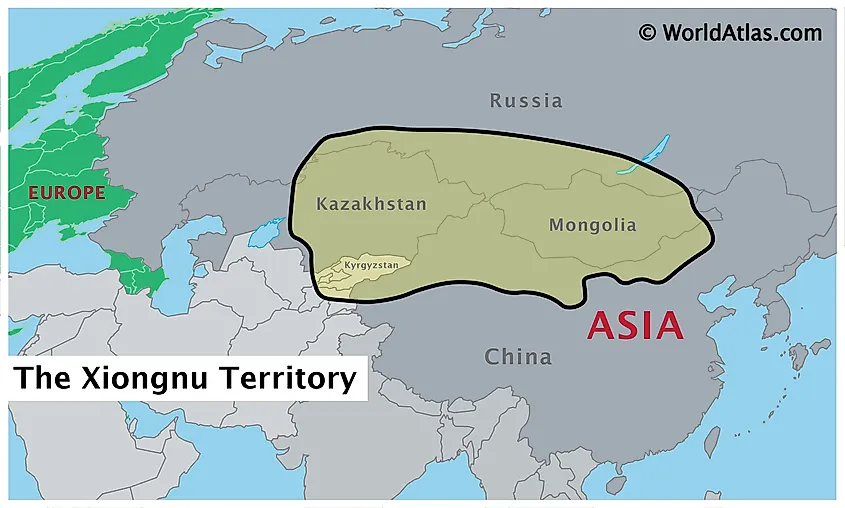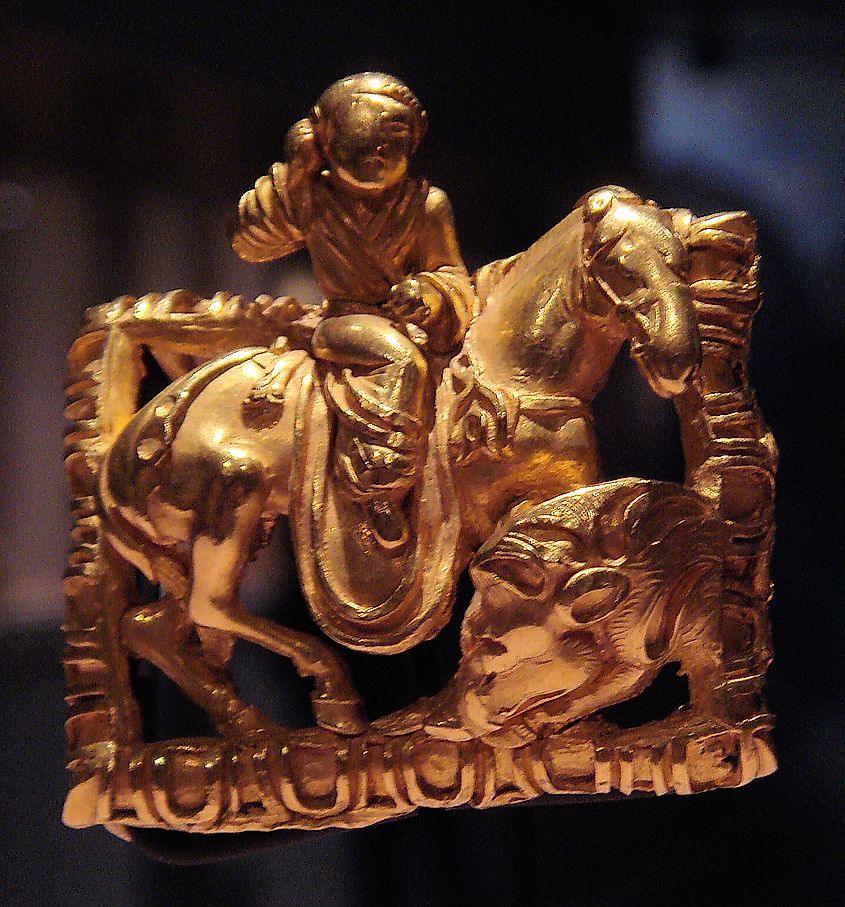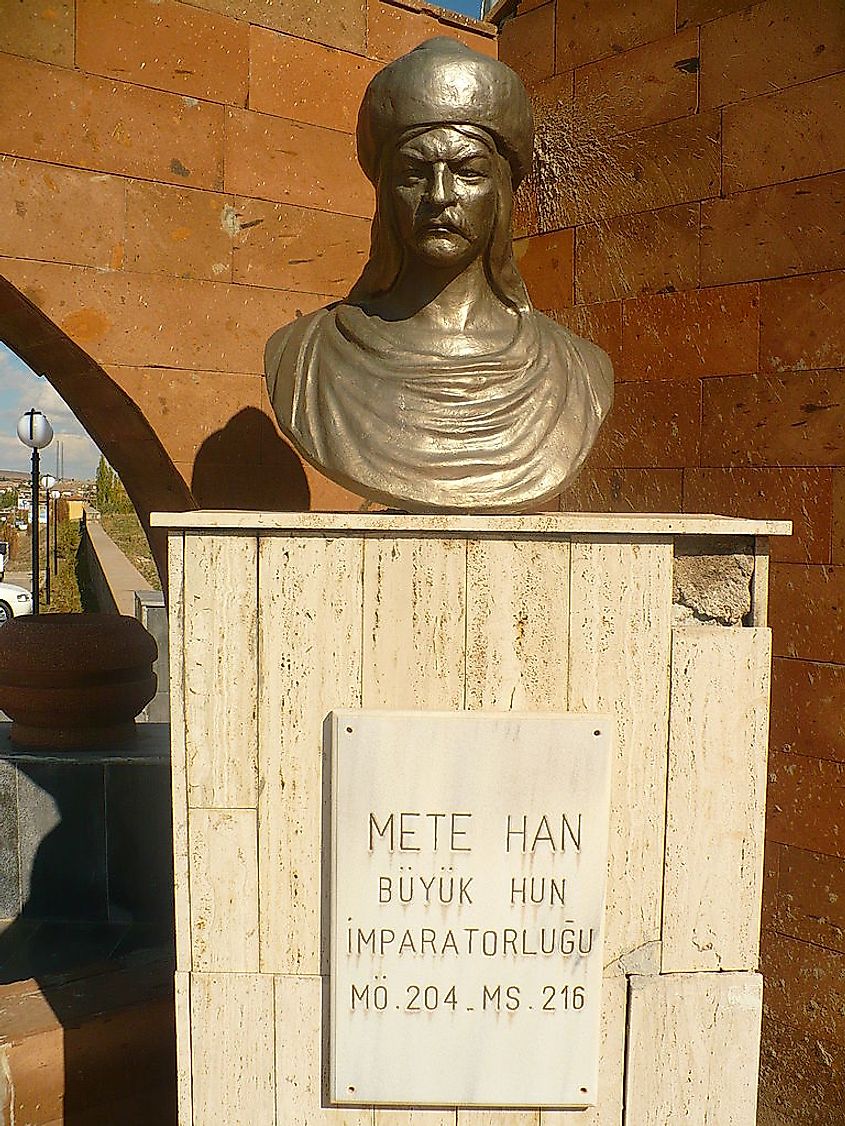
Xiongnu Empire
The Xiongnu Empire was an empire that extended through what is now Mongolia, northern China, and Central Asia, as far west as the Caucasus Mountains.

Map of the Xiongnu Territory
The Empire lasted from approximately the 3rd century BCE to the 1st century CE. The origins of the Xiongnu are unclear. Even their language is a mystery. It is generally believed that they were a heterogeneous group of nomadic tribes. At first, these tribes were separate, but in the 3rd century BCE, they all united behind one leader. This unity, however, did not last. By the 1st century BCE, the Xiongnu began to splinter. Eventually, some were absorbed into Chinese society, while the rest disappeared in the regions west of China.
Who Were The Xiongnu?

Most of what we know about the Xiongnu comes from Chinese historical sources, which are usually depicted negatively. It is not surprising as the Xiongnu and the Chinese had a history of conflict with each other. According to Chinese historian Sima Qian, the Xiongnu are the descendants of a person named Chunwei, who may have been a son of Jie, the last ruler of China’s first dynasty, the Xia Dynasty. There is no direct evidence, however, to support this theory. Furthermore, historical evidence of the Xia Dynasty itself is limited. The Xiongnu’s origin is in the Ordos Desert, located in the northern parts of present-day China.
As for the language of the Xiongnu, scholars are divided. Some believe that the Xiongnu spoke a Turkic language, while others believe their language was of Mongolic origin. One reason that it is so difficult to ascertain what language the Xiongnu spoke is that they left almost no evidence of writing. The only writing attributed to the Xiongnu is rock art consisting of petroglyphs and a few painted images found in present-day northern China. Some scholars have compared the petroglyphs to the Orkhon script, the earliest known Turkic alphabet, and have suggested that the two are connected. There is also no agreement on the ethnic origins of the Xiongnu. However, the latest scholarly research on the subject points to the likelihood that they were heterogeneous, meaning that they were composed of various groups.
What is certainly known about the Xiongnu is that they were generally nomadic, though, by the 1st century BCE, some of their population did live in permanent settlements. Herding was the mainstay of the Xiongnu economy, though they also grew millet, barley, and wheat. The Xiongnu were excellent horsemen who excelled in using the bow and arrow. These two qualities helped them expand their empire. The Xiongnu worshiped heaven, Earth, the sun, the moon, and their ancestors in terms of religion. They had a shamanistic culture in which shamans could exert great influence among their people.
Modu Shanyu And The Birth Of The Xiongnu Empire

Before the unification of the Xiongnu tribes, the Xiongnu were already a formidable threat to China in the south. In fact, Chinese Emperor Qin Shi Huangdi, who was the first emperor to unify China, had the Great Wall of China built to protect the country from Xiongnu raids. However, the birth of the Xiongnu Empire is largely attributed to one man, who was named Modu. In 209 BCE, Modu united the various Xiongnu tribes under his rule. He took the title of shanyu (Supreme Ruler) and was henceforth known as Modu Shanyu. Modu Shanyu established a state with a dual political system, establishing the left and right branches of the Xiongnu on a regional basis while keeping control of the central territory for himself. The de facto capital of the Xiongnu Empire was known as Longcheng and was located in present-day Mongolia.
After unifying his people, Modu Shanyu proceeded to expand his new empire on all sides. He conquered the nomadic people of Siberia to the north, the Donghu of eastern Mongolia and Manchuria to the east, and the Yuezhi to the west. In 200 BCE Modu Shanyu fought a pivotal battle with Chinese Emperor Gao of the Han Dynasty known as the Battle of Baideng, during which 300,000 Xiongnu cavalrymen supposedly ambushed the latter. Gao narrowly avoided being captured himself after the battle. This devastating defeat and another subsequent defeat at Pingcheng persuaded the Chinese emperor to give up on a military solution to the Xiongnu threat and pursue peace. The peace that Han China sealed with the Xiongnu came in the form of a tributary relationship. China agreed to give the Xiongnu a Han princess as a bride to Modu Shanyu and periodic gifts of silk, liquor, and rice. This arrangement paved the way for similar agreements between Han China and the Xiongnu Empire for the next 60 years. Eventually, however, the Chinese found this tributary arrangement costly and ineffective. Although it was supposed to guarantee peace, the fact was that Xiongnu raids into China continued.
Ongoing Conflict With China And The Division Of The Xiongnu Empire
In 129 BCE, the Xiongnu Empire was once again at war with Han China. The Chinese launched a series of military campaigns into Xiongnu territory. Some of these campaigns were successful, while others were not. Intermittent violent conflict between the Xiongnu Empire and Han China would continue for a century. Meanwhile, by the 1st century BCE, divisions among the leaders of the Xiongnu Empire began to appear. These divisions were especially evident when local kings refused to attend annual meetings with the shanyu. The deepening divide among the Xiongnu boiled over in the mid-1st century BCE, when the empire was divided into two parts. One was the Eastern Xiongnu, under the leadership of Huhanye Shanyu. The other was the Western Xiongnu, led by Huhanye’s brother, Zhizhi Shanyu.
The Eastern Xiongnu pursued a tributary relationship with Han China, but unlike the last tributary arrangement between the Xiongnu and the Chinese, this arrangement would favor the latter. Huhanye Shanyu was compelled to pay homage and present tribute to the Chinese emperor. Upon hearing of this arrangement, Zhizhi Shanyu also tried to broker tributary arrangements with China, but since he was unwilling to pay homage to the Chinese emperor directly, preferring to send envoys instead, the Chinese refused to accept him and the Western Xiongnu into the tributary system. Finally, in 36 BCE, the Chinese captured and killed Zhizhi Shanyu, ending the Western Xiongnu Empire.
Fall Of The Xiongnu Empire
Another conflict over succession in the mid-1st century CE led to the division of the Eastern Xiongnu, based mainly in Outer Mongolia, into northern and southern parts. The southern Xiongnu pursued a tributary relationship with China. Eventually, they were resettled on China’s northern frontier, and mixed communities of Xiongnu and Chinese began appearing in northern China. In the late 1st century CE, the Northern Xiongnu were driven out of Outer Mongolia by another nomadic steppe people, the Xianbei, who were of Tungusic/Mongol origin. These Xiongnu fled west to Dzungaria, in what is now the northwest Chinese province of Xinjiang, but eventually, the Xianbei drove them from there as well. There is no more mention of the Xiongnu who fled from Dzungaria past the year 170 CE. It has been suggested that they eventually became the Huns that settled on the frontiers of Europe around 370 CE. Some scholars have accepted this theory, including some from China, though it is certainly not universally accepted. As for the Xiongnu left in northern China, references to them do not show up in Chinese sources past the 5th century CE.











